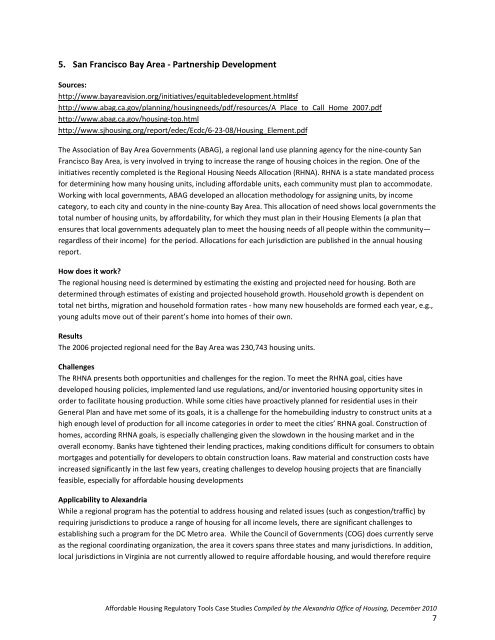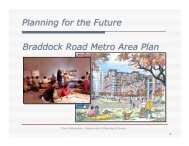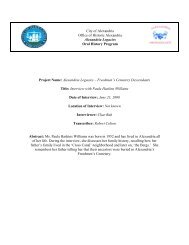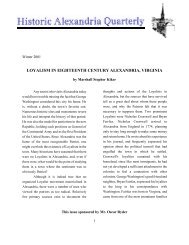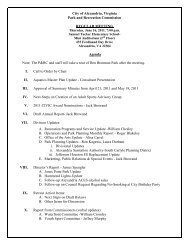Case Studies - Affordable Housing Regulatory ... - City of Alexandria
Case Studies - Affordable Housing Regulatory ... - City of Alexandria
Case Studies - Affordable Housing Regulatory ... - City of Alexandria
You also want an ePaper? Increase the reach of your titles
YUMPU automatically turns print PDFs into web optimized ePapers that Google loves.
5. San Francisco Bay Area ‐ Partnership Development<br />
Sources:<br />
http://www.bayareavision.org/initiatives/equitabledevelopment.html#sf<br />
http://www.abag.ca.gov/planning/housingneeds/pdf/resources/A_Place_to_Call_Home_2007.pdf<br />
http://www.abag.ca.gov/housing‐top.html<br />
http://www.sjhousing.org/report/edec/Ecdc/6‐23‐08/<strong>Housing</strong>_Element.pdf<br />
The Association <strong>of</strong> Bay Area Governments (ABAG), a regional land use planning agency for the nine‐county San<br />
Francisco Bay Area, is very involved in trying to increase the range <strong>of</strong> housing choices in the region. One <strong>of</strong> the<br />
initiatives recently completed is the Regional <strong>Housing</strong> Needs Allocation (RHNA). RHNA is a state mandated process<br />
for determining how many housing units, including affordable units, each community must plan to accommodate.<br />
Working with local governments, ABAG developed an allocation methodology for assigning units, by income<br />
category, to each city and county in the nine‐county Bay Area. This allocation <strong>of</strong> need shows local governments the<br />
total number <strong>of</strong> housing units, by affordability, for which they must plan in their <strong>Housing</strong> Elements (a plan that<br />
ensures that local governments adequately plan to meet the housing needs <strong>of</strong> all people within the community—<br />
regardless <strong>of</strong> their income) for the period. Allocations for each jurisdiction are published in the annual housing<br />
report.<br />
How does it work?<br />
The regional housing need is determined by estimating the existing and projected need for housing. Both are<br />
determined through estimates <strong>of</strong> existing and projected household growth. Household growth is dependent on<br />
total net births, migration and household formation rates ‐ how many new households are formed each year, e.g.,<br />
young adults move out <strong>of</strong> their parent’s home into homes <strong>of</strong> their own.<br />
Results<br />
The 2006 projected regional need for the Bay Area was 230,743 housing units.<br />
Challenges<br />
The RHNA presents both opportunities and challenges for the region. To meet the RHNA goal, cities have<br />
developed housing policies, implemented land use regulations, and/or inventoried housing opportunity sites in<br />
order to facilitate housing production. While some cities have proactively planned for residential uses in their<br />
General Plan and have met some <strong>of</strong> its goals, it is a challenge for the homebuilding industry to construct units at a<br />
high enough level <strong>of</strong> production for all income categories in order to meet the cities’ RHNA goal. Construction <strong>of</strong><br />
homes, according RHNA goals, is especially challenging given the slowdown in the housing market and in the<br />
overall economy. Banks have tightened their lending practices, making conditions difficult for consumers to obtain<br />
mortgages and potentially for developers to obtain construction loans. Raw material and construction costs have<br />
increased significantly in the last few years, creating challenges to develop housing projects that are financially<br />
feasible, especially for affordable housing developments<br />
Applicability to <strong>Alexandria</strong><br />
While a regional program has the potential to address housing and related issues (such as congestion/traffic) by<br />
requiring jurisdictions to produce a range <strong>of</strong> housing for all income levels, there are significant challenges to<br />
establishing such a program for the DC Metro area. While the Council <strong>of</strong> Governments (COG) does currently serve<br />
as the regional coordinating organization, the area it covers spans three states and many jurisdictions. In addition,<br />
local jurisdictions in Virginia are not currently allowed to require affordable housing, and would therefore require<br />
<strong>Affordable</strong> <strong>Housing</strong> <strong>Regulatory</strong> Tools <strong>Case</strong> <strong>Studies</strong> Compiled by the <strong>Alexandria</strong> Office <strong>of</strong> <strong>Housing</strong>, December 2010<br />
7


